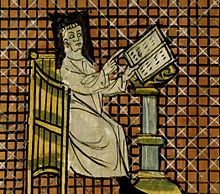Roman de Renart
Le Roman de Renart , the fox novel , is a work of old French literature that originated in northern France from around 1170 and significantly influenced the subsequent fox poems in Europe.
Origin and tradition
The first version of this work, which was updated until around 1250, was probably written by a Pierre de Saint-Cloud on the basis of Middle Latin models (especially the Ysengrimus des Nivard of Ghent ) , whose existence is only proven by the fact that unknown authors report about him in some parts of the novel according to which he worked on the story between 1174 and 1177. Pierre's text was then varied and redesigned in so-called branches over a period of more than a hundred years by around twenty different authors who remained anonymous . The Roman de Renart has survived in 20 manuscripts and fragments, which together comprise around 25,000 verses.
content
The Roman de Renart is not a novel , but a collection of episodes based on different sources. Protagonist of the narrated in octosyllabic and paired rhyming verses, partly fluctuating liable animal episodes is the sly fox who always seeks only his own advantage, and sometimes more, sometimes less adventurous and successfully achieved this at the expense of other livestock and sometimes people. Thus, for example in the sector II , the fable of Aesop the fox and raven, which drops the cheese while singing, told. The fish adventure ( branch III ), in which the fox plays badly with the wolf when fishing, comes from the Middle Latin Ysengrimus and has been preserved to this day through the numerous later adaptations of the fox material , as well as the fountain adventure in which the fox takes the wolf in Bucket hanging.
The court day at King Noble's , during which the animals complain against the fox, goes back to the Middle Latin Ecbasis captivi ; the castle of the fox, Malepartus (French Maupertuis ), is painted in detail in the Roman de Renart and manifests the role of Renart as baron revolté , the nobleman who constantly endangers the power of the king.
The animals in the Roman de Renart are anthropomorphic figures, which increasingly received proper names with which they were identified in later adaptations in Europe.
features

The Roman de Renart was originally a humorous-realistic and partly parodistic contrast program to the more idealistic courtly novel , as it has been handed down for example by Chrétien de Troyes . The addressed readers or listeners were initially the same as that of the courtly novel. However, the Renart quickly caught on with the urban bourgeois public , which began to develop around 1200.
The character of the devious Renart became so popular through the novel that his name (which corresponds to the German "Reinhard") became a word that replaced the original French word for "fox", goupil , as renard .
reception
The stories collected in the Roman de Renart form an important source of the European wildlife spike . Various versions of the Reineke-Fuchs fabric are based directly or indirectly on the old French model.
The Renart le Nouvel , a new Renart , written by a Jacquemart Gielée at the end of the 13th century, emphasizes the fox as an allegory of evil with moral intent . A Middle High German fox poem based on the Roman de Renart , Reinhart Fuchs , was written by the Alsatian Heinrich towards the end of the 12th century , presumably as a criticism against the Hohenstaufen . The middle Dutch animal pos of a Flemish named Willem from the 13th century, Van den vos Reynaerde , contains clear traces of the Roman de Renart . The expansion of this story by an unknown editor in the 14th century as Reynaerts Historie became fundamental for the dissemination of the material throughout Europe thanks to the early printing press . Today, the best-known German version of the epic, which goes back to the old French novel through the Middle Dutch, is Johann Wolfgang von Goethe's Reineke Fuchs .
From 1929 to 1931, the puppet animator Władysław Starewicz filmed the fox poem under the title Le Roman de Renard as a full-length animation film . After the dubbing of the film remained unfinished for years, the work was finally premiered in Berlin in 1937 under the title Reineke Fuchs . The French-language original version was not completed until 1941.
Individual evidence
- ^ Illustration and commentary (French) from the Bibliothèque nationale de France, Paris: [1]
- ↑ According to the information from the Bibliothèque nationale de France, Paris: [2]
- ↑ Roman de Renart : The fox and the raven ; Bibliothèque nationale de France, Paris
- ^ Roman de Renart : Fish adventure ; Bibliothèque nationale de France, Paris
- ^ Roman de Renart : Well adventure ; Bibliothèque nationale de France, Paris
- ↑ Roman de Renart : Renarts Castle Maupertuis ; Bibliothèque nationale de France, Paris
- ^ Roman de Renart : Figures; Bibliothèque nationale de France, Paris
- ^ Renart le Nouvel , Bibliothèque nationale de France, Paris
- ^ Richard Neupert: French Animation History . Wiley-Blackwell, Chichester 2011, ISBN 978-1-4443-3836-2 , p. 63.
literature
- Jauss-Meyer, Helga: Le Roman de Renart , Munich 1965, 259 pp. (French text in verse, with German translation in prose).
Web links
- List of manuscripts and research bibliography at the Archives de littérature du Moyen Âge (ARLIMA)
- Le roman de Renart (French)
- Article in: Gert Pinkernell: names, titles and dates of French literature .
- Léopold Sudre: Les sources de Roman de Renart. 1893 (digitized by Gallica / BNF)
- Animals in Medieval Illuminations (French) - Website of a bestiary exhibition of the Bibliothèque nationale de France (BNF); including a link to the Roman de Renart : introduction (audio version) to the work and scans of some pages
- Le Roman de Renart, Ed. Ernst Martin (1882), Vols. II , III .

